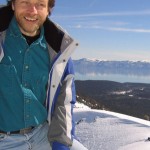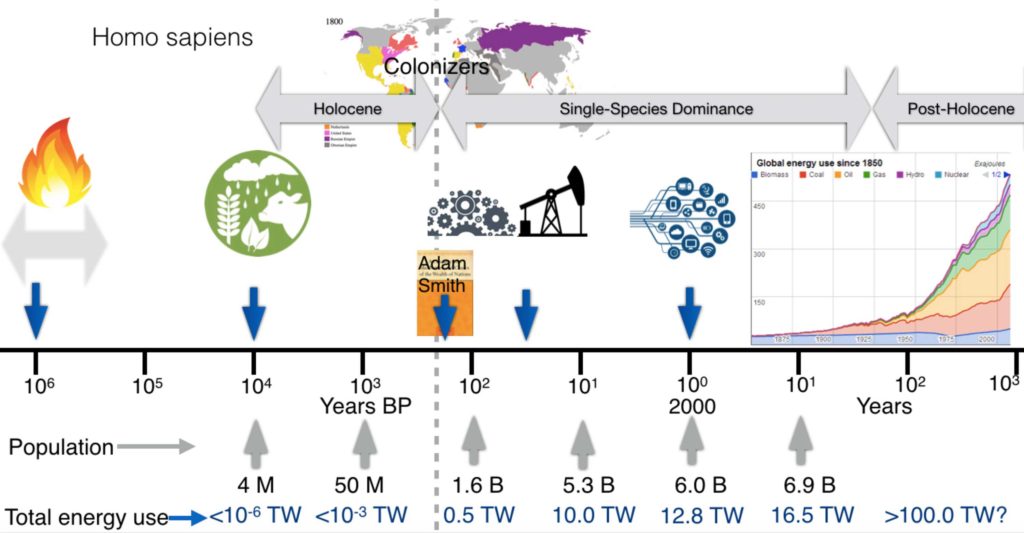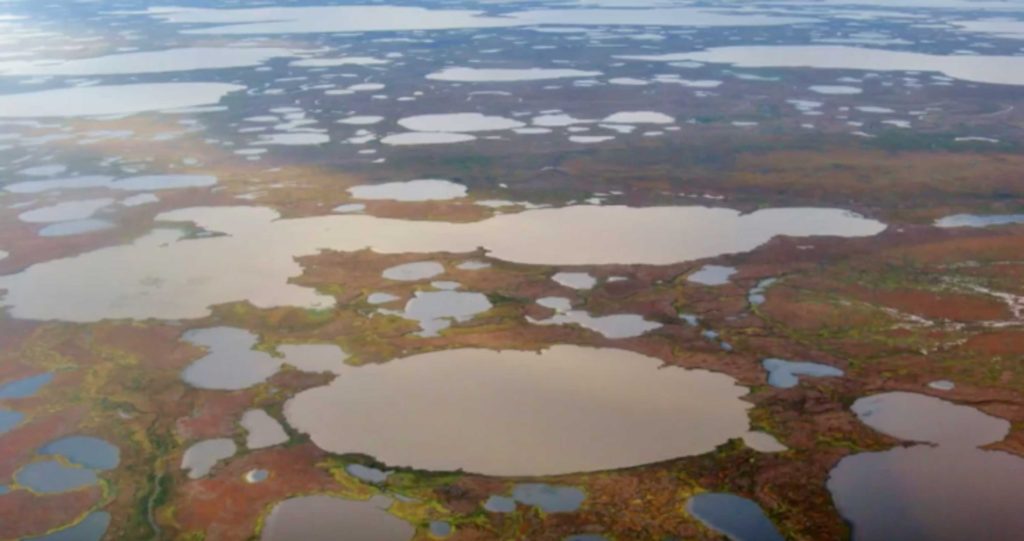
Prof. Hans-Peter Plag, PhD
Mitigation and Adaptation Research Institute
Old Dominion University Norfolk, Va.
www.mari-odu.org
CLIMATE IS CHANGING AT A MUCH HIGHER rate during the last century than during the Holocene, the last geological epoch that started approximately 11,700 years ago.1 This rapid recent climate change is part of a much larger syndrome and can only be characterized and understood as part of this syndrome. My last column discussed how distance impacts our perception of our planet. Moreover, each of us looks at our personal world through individual lenses, which determine what we see, including how we perceive our home planet and interpret what is currently taking place.
Previously, I have asked my students to assume the identity of an alien coming to Earth to find out whether there is intelligent life with whom they would want to engage in diplomatic relationships.2 Here, I want to look at our planet through the lens of an alien who has been sent out to identify planets with a degrading life-support system (Figure 1). The task of these planetary doctors is to diagnose a planetary patient and to propose a therapy. For the alien observer, the planetary system is a life-support system for a very large number of fine-tuned systems of species that are interacting dynamically with each other to keep the life-support system in a homeostasis not unlike that of an individual organism, such as a human body. Of course, being this planetary doctor challenged with the task of diagnosing the patient and developing a therapy, there can be no preference for a single species or a group of species in the life-support system.

FIGURE 1. Coming to Earth in an alien spaceship and measuring the planet’s global energy balance, the aliens would immediately conclude that Earth is storing 3*10-3 of the incoming solar energy, a total of 320 TW. Over just a century, this very large imbalance would heat the planet rapidly with most of the heat being stored in the vast ocean that is so characteristic for the blue planet. In fact, at this rate, the planet would store in one century as much energy as a healthy planetary life-support system would store in more than 100 million years.
Coming across this beautiful, water-rich planet, it was immediately clear that its life-support system was in extreme disarray. One of the core planetary indicators is the flow of energy into the planetary system and out of it. For a healthy planetary life-support system, this imbalance should be very small: less than a billionth part of the incoming energy should be stored in the system. Using my instruments to determine the planetary energy imbalance revealed that the blue planet is currently storing more than 0.3% of the incoming solar energy—that is, 10 to 100 million times what a healthy system would store.
More than 90% of the 320 TW is stored in the ocean3 leading to rapid warming of the hydrosphere. Over the course of only one century, the current rate would lead to an increase of the energy in the climate system of 1000 ZJ (one ZJ is 1021 Jules). This planetary “fever” would very likely lead to a significant state shift of the life-support system of any water-rich planetary system. There was extreme urgency to find the source of this energy imbalance and to develop a therapy to correct it.
Descending to the planet’s surface, I was able to tap into the large data and knowledge base acquired by one species calling itself Homo sapiens. Their data showed a clear picture: the life-support system of this planet, which they called Earth, was rapidly deteriorating.
A surprising contradiction arose between Homo sapiens’ ability to develop a high level of technology that allowed them to change the planetary system at their will and to collect huge amounts of data documenting the large detrimental impacts resulting from these changes, and their inability to diagnose the planetary patient, to understand the causes of the deterioration of their planetary life-support system, and to act on available therapies.
A planetary life-support system is similar to the organism of an animal, in which many fine-tuned processes generate flows that keep the organism in homeostasis. The animal organism provides a life-support system for many other organisms that are crucial for the generation of the flows that maintain the homeostasis. Central to the understanding of the physiological functioning of a body system is the integrated nature of chemistry and physics, coordinated homeostatic control mechanisms, and continuous communication between cells.4 The same applies to the understanding of the functioning of a planetary life-support system, in which the homeostatic control mechanisms are provided by the continuous interaction of the “web of life” constituting the life-support system.
For a homeothermic species, fever is a symptom of a malfunctioning of the organism’s system and often part of a syndrome of changes in the body resulting from disruptions in the physiology of the organism. Disruptions can result, for example, from a breakdown of homeostatic control mechanisms, alterations of flows, or the attack of viruses or bacteria. A thorough cure is only possible if the source of the disruption can be identified.
Similarly, a significant rapid increase in the heat stored in the coupled atmosphere-ocean system is a result of a disruption in the physiology of the planetary life-support system. The symptom of “global warming” indicates that the physiology of the life-support system has been changed and the processes in the life-support system no longer are functioning to keep the system in its homeostasis. Consequently, only by considering the full physiology of the life-support system can the symptoms of “global warming” and recent “climate change” be fully characterized, understood, and traced back to the underlying causes, the “sickness.”
Life impacts the “physiology” of a planetary life-support system from the start by creating and changing flows and to some extent, this determines many chemical and physical variables throughout time. During many periods of stability in Earth’s long history, the flows manipulated by life kept the system in homeostasis and provided stable environments for life to evolve and occupy large regions of the planetary surface.
At these times of stability, the imbalance between incoming and outgoing radiation was on the order of 10-10 to 10-9 of the total solar energy reaching Earth. Most of this imbalance resulted from plants using solar energy to produce biomaterial that is being deposited in subsurface reservoirs of fossil fuels as well as other chemical reaction fueled by solar energy. Changes in the flows were slow and allowed species to adapt equally slow to changes in the mean state of the life-support system. Distortions in flows happened, though, for example, through volcanism, impacts of large asteroids, or positive feedback loops that triggered large changes in the chemistry of ocean or atmosphere. These distortions led to mass extinctions, but over time, biodiversity kept slowly increasing.5
The energy used by all but one species to generate and modify flows is at a very low level compared to the incoming solar energy. The energy usage across species is fairly evenly distributed. The metabolic rate (that is, the energy needed to keep the organism alive) of any animal depends on the mass of the animal with the same scaling law connecting individual species within groups such as homeotherms.6 Of course, any animal needs slightly more than the metabolic base rate since energy is needed for the body’s work in collecting food, hunting, and building dens, but the “extended metabolic rate” that includes this additional energy is only slightly larger than the metabolic base rate.
For most species, the availability of food that provides the energy at this metabolic rate limits the options of developing larger bodies, and it also determines the ratio of brain to body size. Brains are high-energy organs, and being able to provide food in a form easily digested is a prerequisite for developing larger brains.6 What is remarkable is that Homo sapiens found a way to extract the base rate energy from food far more efficiently than most other species through the use of fire to process food.8 Utilizing fire to process food put Homo sapiens on a distinctly different evolution path7 because they could afford to develop larger, energy-demanding brains.
At the same time, it freed time that previously had been used to find and metabolically process the food. Using fire to clear forests and other land covers for agriculture and pastures made food supply easier to get and freed time for other activities. This larger brain could be used to develop technologies to utilize more and more energy to transform the environment. This triggered a development that eventually led to the high-energy pulse humans are causing in the planetary life-support system of their planet.
For Homo sapiens, the scaling law for the basic metabolic rates indicates a range of the metabolic rate of 50 to 100 W, depending on age, gender, and mass. When I reached Earth, on average, each human was utilizing more than 2800 W to sustain itself, more than 30 times the basic metabolic rate. No other species on Earth was using (and wasting) so much energy to sustain itself. In total, the species is using nearly 19 TW mainly to change the Earth’s carrying capacity and to sustain rapid growth of the human population – at the same time causing an equally rapid decline of all other animals in number and diversity. Surprisingly, humans knew about the rapid extinction they were causing but were unable to act on this knowledge.
Why did Homo sapiens not see what was down the track they chose? Or, to be more precise, why did the leaders not want to listen to those of them who saw that down that path there was a broad spectrum of undesirable futures – futures with a dysfunctional life-support system, a high-energy climate system with significantly changed extremes, and a planetary system with a significantly reduced carrying capacity requiring dramatic reductions in the number of humans on Earth? Humans had compiled a vast knowledge base including many well-reasoned scenarios that should have triggered efforts to change the path – but it didn’t. Why? Were they blinded by their “success”?
Over many millennia, the human development seemed positive, bringing a safer life to many of their communities (Figure 2). It appears that this slowly changed, particularly in a geographic area humans call Europe, where an aggressive subspecies with very light-colored (almost white) skin started to develop a so-call “economic model”, i.e., the rules that regulate the flows between the life-support system and human communities and the distribution of benefits of these flows. The rules of this emerging model were put down in writing by Adam Smith,9 a “white male” who defined the purpose of economy as the creation (and accumulation) of “human wealth” – and with this changed the purpose of the flows between humans and the planetary life-support system from sustaining healthy human communities to increasing and accumulating an imaginary quantity denoted as “human wealth.” Whites, in particular, white males became the colonizers who spread out across the globe taking whatever “wealth” they could from others and enslaving them in different forms to create new opportunities to accumulate. In some cases, killing the indigenous populations of human and non-human animals (such as the millions of buffaloes in North America) was seen as a way to open an option for accumulation and the white male proceeded along this track with little consideration for other lives.

FIGURE 2. The single-species high-energy pulse had its origin in Homo sapiens learning to utilize fire to process food, which provided a basis for increas- ing the brain-body ratio. Late fire was used to clear spaces for agriculture. The focus on accumulation of human wealth in Europe and the disregard of the Earth’s life-support system and the future led to an unparalleled single-species dominance and rapid degradation of the life- support system for all.
The amount of wealth accumulated by individuals and groups was soon (mis)used to define the hierarchy of humans within a given community. The economic system was twisted towards more options for wealth accumulation by increasing production, consumption and profits, with little consideration for the impacts on the Earth’s life-support system. Unfortunately, the most efficient way of increasing the accumulation of wealth was by increasing consumption far above what was needed.
At the time that Adam Smith redefined the purpose of economy, humanity had reached 650 million in numbers and had little technology and access to energy to modify the life-support system at a large scale. But this changed rapidly: initial wealth accumulation allowed the development of new technologies and to tap into the huge energy reserve the planetary life-support system had accumulated over hundreds of millions of years in the form of fossil fuels. This allowed humans to increase their numbers tenfold within a little more than 200 years. The perverted economic system forced more and more of them into overconsumption to allow a few to accumulate massive amounts of wealth.
At the time of my visit, a group of their scientists had come together to assess the state of the biosphere, and they found that the degradation of the land surface posed a threat comparable to the threat of a shift in the climate state of the planet.9 Scientists also detected more and more positive feedback loops further accelerating the changes (Figure 3). The threats were well known, but little to no action was taken to reduce these threats. There was no end to growth addiction and the desire to accumulate endlessly.

FIGURE 3. The change of the global energy imbalance is triggering many positive feedbacks putting the Earth system on a path of increasing imbalance. For example, permafrost melting leads to more surface water and a change in albedo which increases the rate of melting and of release of carbon dioxide and methane.
It became clear to me that there was little that could be done. Only if humans would be willing to transition to an economy that meets their needs of the present while safeguarding the Earth’s life-support system, on which the welfare of current and future generations depends, was there any hope to end the single-species high-energy pulse and have the life-support system slowly recover to a reasonable planetary energy imbalance. I sent this message to humanity and then left Earth. I hope that the message will be heard and acted upon by their leaders.
Endnotes:
1. Gaffney, O., Steffen, W., 2017. The
Anthropocene equation. The Anthropocene Review, 4(1), 53-61, DOI: 10.1177/2053019616688022.
2. Plag,H.-P.,2016.ALookatEarth from Aliens’ Perspective. “On The Edge.” Apogeo Spatial, 31(4), 12-15, Fall 2016.
3. Cheng,L.,Trenberth,K.E.,Palmer,M.D., Zhu, J., Abraham, J. P., 2016. Observed and Simulated Full-Depth Ocean Heat-Content Changes for 1970–2005, Ocean Science, 12, 925-935,
DOI:10.5194/os-12-925-2016.
4. Widmaier,EricP.;Raff,Hershel; Strang, Kevin T. (2016). Vander’s Human Physiology: The Mechanisms of Body Function. New York, NY, McGraw-Hill Education.
5. Rohde, R.A., Muller, R. A., 2005. Cycles in Fossil Diversity. Nature, 434, 208-210.
6. West, G. B., Brown, J., and Enquist, B. J., 1997. A General Model for the Origin of Allometric Scaling Laws in Biology. Science, 276(5309), 122-126, DOI: 10.1126/science.276.5309.122.
7. Herculano-Houzel, S., 2017. The Remarkable (but Not Extraordinary) Human Brain. Scientific American Mind, 28(1), 36-41.
8. Wrangham, R., 2010. Catching Fire – How Cooking Made Us Human. Basic Books, New York.
9. IPBES, 2018. Summary for Policy- Makers of the Thematic Assessment of Land Degradation and Restoration of the Intergovernmental Science- Policy Platform on Biodiversity and Ecosystem Services. R. Scholes, L. Montanarella, A. Brainich, N. Barger, B. ten Brink, M. Cantele, B. Erasmus, J. Fisher, T. Gardner, T. G. Holland, F. Kohler, J. S. Kotiaho, G. Von Maltitz, G. Nangendo, R. Pandit, J. Parrotta, M. D. Potts, S. Prince, M. Sankaran and L. Willemen (eds.). IPBES secretariat, Bonn, Germany.
![]()




